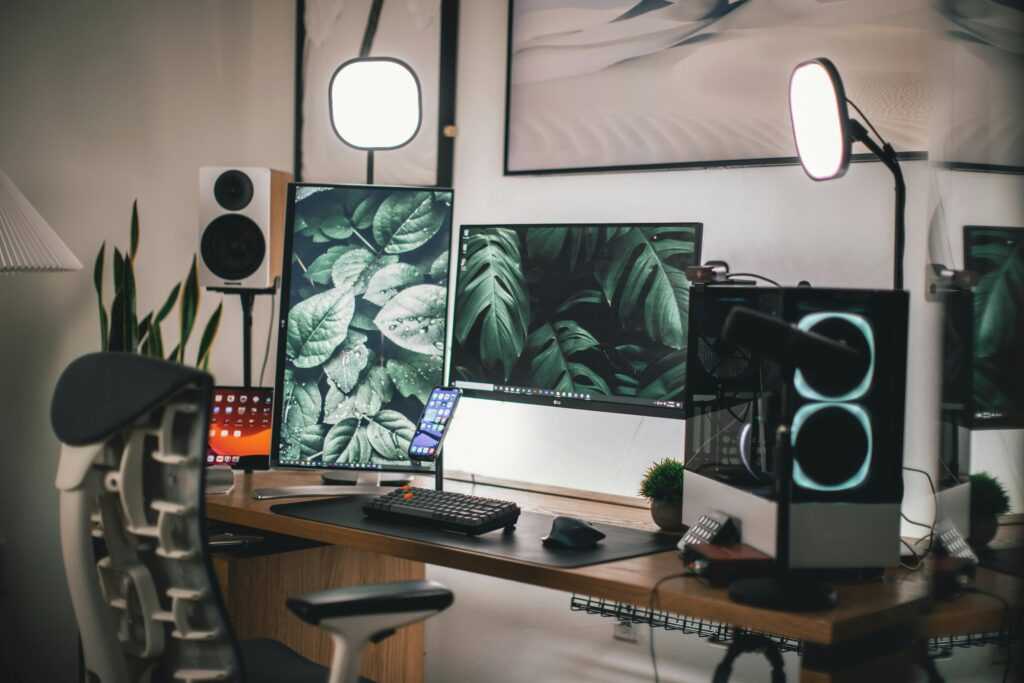Zoning the space
For me, one of the clearest and most effective approaches is clear separation of zones. Even in a small apartment, you can visually or functionally divide the workspace from the relaxation area. For example, using a bookshelf as a partition, rearranging the desk, or adding a small rug. This approach helps create a sense of order and predictability: when the division is clear, it’s easier to focus on work or, on the contrary, fully relax.
I think zoning isn’t just about physical barriers. It’s also about a psychological separation of tasks. When there’s a dedicated corner for work, the brain gradually learns to switch into work mode specifically there. Meanwhile, an armchair by the window or a sofa with a throw becomes a symbol of rest. Even if space is limited, you can define a “work sector” with lighting or a rug, add a shelf for documents, or set up a small table just for the laptop.
Attention to details like equipment settings helps with this task – even the right valorant sensitivity converter allows you to fine-tune peripheral devices for gaming and work, which in itself disciplines you and reinforces the purpose of each zone. I think these small but precise adjustments help maintain a sense of control over your space and time.
I also find it important to consider personal habits. Some people prefer to completely close off the work area with a screen at the end of the day so they don’t see it in the evening. Others leave it open but decorate it to look cozy and informal. That’s the point of zoning – not about strict rules, but about creating a space that adapts to your rhythm and tasks.
Lighting for tasks

I think lighting is one of the most flexible tools for creating the right atmosphere. Light literally sets the pace for what you’re doing and can help you either focus or relax. For example, cool white light is better suited for work tasks: it stimulates attention and helps you stay focused for longer. Warm light, on the other hand, is softer and cozier, making it great for reading, conversations, or evening relaxation.
I find it important not to overcomplicate this topic. Even something as simple as replacing a bulb or buying a desk lamp has a noticeable effect. It doesn’t require serious investment or renovation. It’s enough to think about the lighting scenarios you need: bright, directed light for your work desk, a soft floor lamp for a relaxation area, or string lights and dimmable lamps for cozy evenings.
I also pay attention to the possibility of adjustment. A lamp with different brightness levels or color temperatures helps adapt the space to different tasks throughout the day. It’s a convenient way to feel more comfortable and manage your focus without drastic changes to the interior. Essentially, lighting becomes a tool for structuring the day, gently signaling a shift in roles: work is done – it’s time to switch to rest.
Minimalism and order
I appreciate the idea of simplifying the environment around me. I think that when there are fewer unnecessary things around, it becomes easier to focus and plan the day without chaos. It’s not about sterility or completely getting rid of personal items, but rather about making sure everything has its place and doesn’t draw attention unnecessarily.
Even small baskets, organizers, under-desk drawers, or neat shelves can make life noticeably simpler. I believe that order by itself lowers background anxiety – there’s less visual noise and fewer thoughts about needing to “clean up.” Instead, there’s a sense of control and clarity that helps you settle into work or relax peacefully.
Additionally, minimalism doesn’t have to be strict or austere. I like the idea of “warm minimalism,” where important and pleasant items remain – books, souvenirs, photos – but in a moderate amount. This helps create a cozy atmosphere without clutter. In the end, the space becomes more flexible: it’s easier to adapt it to different tasks and moods without the constant need to tidy up.
Decor for inspiration

I think it’s important to remember the pleasant details that give a space its individuality. A couple of posters, plants, a cozy throw, or a beautiful cushion aren’t just decorations – they’re a way to truly make a home your own. These things help you feel more comfortable and give the sense that the place around you genuinely reflects your character and interests.
I like the idea of choosing decor consciously rather than just “filling empty space.” It matters that these elements match your mood and have personal meaning. Maybe it’s a painting you’ve wanted to hang for a long time, a favorite plant on the windowsill, or an old lamp with a bit of history. Such items become small mood anchors and even remind you of goals and dreams.
I think even little things can set the right tone for a productive day or a relaxing evening. They help you switch between roles – from work mode to homey comfort. In the end, the space stops being just a place with furniture and equipment and becomes a true environment for living and creating.
Conclusion
I’m convinced that small home improvements don’t just make it easier to work or relax effectively—they also help you feel better in that space. It’s not necessarily about expensive renovations or major changes—so much can be achieved by paying attention to details and understanding your own needs. Lighting, order, zoning, and decor are all tools you can use flexibly and gradually, adapting them to your own pace of life.
For me, it’s important that any changes are intentional and truly fit my own goals and style. There’s no universal solution: everyone has their own habits, tastes, and daily plans. But that’s exactly where the value of these upgrades lies—the ability to make the space truly yours, comfortable, and inspiring every day.

